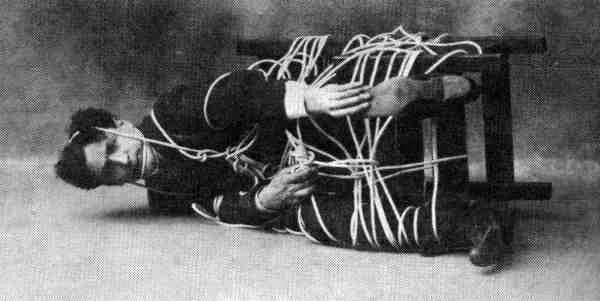The great escape
Escapology is the subclass of magic practiced by escape artists. Escapologists try to escape from physical restraints such as handcuffs, ropes, chains, straitjackets, and locked containers. Modern-day escapologists have unlocked new doors without even needing a key, while pushing the limits of human endurance.
Block, knot or lock: the challenge of escape
Escapology combines elements of magic, theater, and physical skill to captivate and entertain audiences around the world. This article will into the history of escapology, examine the techniques used by escapologists, and explore some of the most famous practitioners of this art genre.

Breaking the chains: understanding escapology
The art of escapology can be traced back to ancient times, with magicians and performers displaying their talents in various cultures. It was in the late 19th and early 20th centuries when escapology began to garner public interest, thanks to the legendary Harry Houdini. Houdini’s daring feats and dramatic performances captivated audiences and helped establish escapology as a popular form of entertainment.
What are techniques in escapology?
The five techniques of escapology are listed below.

-
Lock picking
Escapologists use lock picking tools to manipulate the internal components of a lock, allowing them to handcuffs, padlocks, and other restraints without a.
-
Sleight of hand
Escape artists rely on their skillful manipulation of objects, such as secretly palming. Or using misdirection to distract the audience.
-
Contortionism
Escapologists possess exceptional flexibility, allowing them to contort their bodies to slip out of tight restraints, such as straitjackets or ropes.
-
Misdirection
Escape acts involve misdirection to divert the audience’s attention away from the escape method.
-
Psychological techniques
Escapologists employ psychological techniques, such as building tension and creating anticipation, to enhance the audience’s perception of the difficulty of the escape.
Escapologists use a wide range of techniques to escape from their restraints, employing a combination of physical agility, dexterity, and problem-solving skills.
Who are famous escapologists?
Six notable escapologists are listed below.

-
Harry Houdini
Harry Houdini is the most famous escapologist in history. Houdini was known for his sensational escape acts. He popularized the branch of magic known as escapology. The other talented escape artists have followed in his footsteps.
-
Alan Alan
A British escapologist known for his death-defying feats, Alan Alan was a pioneer in the use of fire and other dangerous elements in his acts.
-
Dorothy Dietrich
Known as the “first lady of magic,” Dietrich was one of the few female escapologists to gain significant fame. She is particularly well-known for her bullet catch trick, a feat previously only performed by male magicians.
-
David Blaine
Blaine is a modern-day magician and escapologist who has gained widespread fame for his combination of street magic and endurance feats, such as being buried alive and encased in a block of ice.
-
Criss Angel
Another contemporary magician, angel has achieved great success through his television series “mindfreak” and his las vegas stage shows. His daring escapes often involve extreme conditions, such as being submerged in water or suspended in mid-air.
-
Jonathan Goodwin
A British escapologist and stunt performer, Goodwin is known for his death-defying escapes and feats of physical endurance. He has starred in several television series, including “the incredible Mr. Goodwin” and “escape artist.”

Free at last: reflecting on escapology
Throughout its history, escapology captured the imagination of audiences around the world. The thrilling combination of physical skill, mental prowess, and the element of danger inherent in many escape acts continues to enthrall spectators. But the essence of escapology remains unchanged – the ability to break free from seemingly impossible restraints, both literally and metaphorically, symbolizing the human spirit’s ability to overcome adversity and limitations. Escapology evolved over time, still retains its core appeal. The daring feats of escape artists, past and present, serve as a testament to the power of ingenuity, determination, and the desire to break free from the constraints that bind us.
